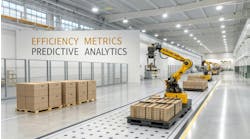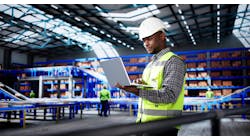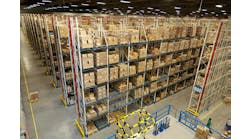If you are still envisioning a warehouse as a cavernous building with little air flow and boxes randomly stacked wherever there is space, you might need to revise your thinking. Although there are certainly facilities in existence that continue to operate the same way they did 50 years ago, today’s competitive business climate has forced most companies to reexamine the warehouse. Organizations are analyzing how the warehouse can move from a lost capital expenditure to a profit center—and the answer usually involves the addition of a piece of technology.
Picture Amazon drones zipping through the skies with customer purchases. Same-day delivery of hard line goods. Groceries coming from neighborhood stores to your door in two hours. All these scenarios are made possible by the future warehouse—one that utilizes warehouse management systems fully integrated with complementary software, robotics and logistics methodologies to ensure customers receive correct merchandise in the shortest time possible.
Let’s examine three of the changes we expect to see in the future warehouse, thanks to advances in robotics, artificial intelligence and shipping automation technologies.
Robotics
As mentioned earlier, some warehouses still haven’t entered the 21st Century. They are dusty, hot (particularly in Southern states) and disorganized—factors that employees routinely ignore or work around. It’s odd to think that they will have the arrival of robots to thank for environmental upgrades.
These less-than-ideal working conditions are probably one reason why workers think their jobs are safe from automation. Earlier this year, National Public Radio and Marist conducted a survey across all industries, and a whopping 94% of responding U.S. workers said their jobs could not be automated. We know for a fact that this isn’t true, at least in the warehouse. One has only to look at the progress being made by Amazon and Walmart in re-imagining the warehouse space to understand there are massive technological changes on the horizon. In fact, companies are already using robotic arms for picking, cultivating a warehouse of the future—one that never stops.
We know robots can boost warehouse productivity, but ironically, robots will also usher in better working facilities. Companies will want to protect their multi-million dollar investments in robotics, which can’t optimally operate in higher temperatures and in air filled with particulates. Since market research firm Tractica estimates that warehouses will spend $22.4 billion on robots in the next three years, it’s easy to deduce that these environmental changes are just around the corner.
Another change will be in the workforce itself. One robotic manufacturer, Fetch, points out that automation can help solve the logistics industry’s problem of an estimated 600,000 unfilled jobs. By turning to robots, warehouses can have the manpower to confidently face the continued growth of e-commerce and the pressures of an on-demand economy.
Does this mean that robots will be zipping alongside human workers, outfitted in orange safety vests and the equivalent of hard-toed boots? Maybe, because robotics will be used to supplement workers in the warehouse, not replace them entirely. Amazon reportedly has increased the number of warehouse robots from 1,400 to 45,000 in the last three years, but has also increased its employees from 90,000 to 360,000. Automation seems to be pushing employee growth, not hindering it.
We’ll probably first see robots helping with picking and sorting, loading and unloading, storage and delivery. For example, you might think that recognizing objects for accurate picking and sorting would not be within a robot’s range of abilities. You’d be wrong. Researchers at MIT and Princeton have successfully trained a robot to correctly grip a piece of inventory and to determine what it is.
We’ll also see improvements in workers’ health, thanks to robots. Pick-and-place is an activity where human workers frequently experience ergonomic issues. High-speed robots, such as the one being developed by MIT and Princeton, have the potential to increase efficiency and decrease repetitive injuries.
Artificial Intelligence
There’s a lot of talk about how artificial intelligence (AI) will improve warehouse operations. That may be true, but there may be a downside for human workers.
At its simplest level, AI is computerized intelligence that comes from crunching massive amounts of data to identify patterns and make predictions. This information can then be leveraged to create operational efficiencies. A potential downside is the duality of data collection—the good side and the bad. It’s possible that AI will devolve into just a contemporary way to track human warehouse workers doing their jobs and to predict their performance.
But despite this potential downside, AI offers tantalizing benefits, and the warehouse and logistics industries are quickly moving forward to adopt AI in its many forms (machine learning, computer vision, natural language processing, etc.). Analysts at MarketsandMarkets have observed that the market for AI is hot, expected to be worth $416 billion by 2022, growing at a CAGR of 62.9% from 2016 to 2022.
In the warehouse, AI is most obviously applicable to repetitive and monotonous tasks, but distribution centers and businesses with warehouses as primary components would do well to look to their KPIs before taking the AI leap. What are you trying to optimize? Whether it’s picking efficiency, order accuracy or safety, the overarching need should dictate what to look for in an AI platform or application.
Let’s examine picking efficiency as an example. AI gives warehouses an opportunity to learn from their most productive workers to create computerized models for entire teams. If you collect data points based on the number of orders, SKUs, picking sequences, traffic patterns, scanned barcodes and more gleaned from the most efficient workers, an algorithm could be created that will replicate their movements and choices. To oversimplify, the AI application could then suggest a workflow for sales order pick tickets that everyone follows, and that may be enough to boost the productivity of lower achievers.
AI is also affecting inventory management. In an article in The Economist, Ralf Herbrich, Amazon’s director of machine learning, stated that the company is using algorithms to predict the demand for millions of products. This determines which product is shipped to regional warehouses, reducing transportation costs and keeping the appropriate items in stock. Other businesses could benefit from similar programs that free up cash and storage space.
Shipping
There is no doubt that the pressure of consumer demand for instantaneous fulfillment is changing the way we think of future warehouses and distribution centers, and their abilities to accommodate faster shipment.
There used to be a question of whether or not customers wanted—and were willing to pay for—faster delivery. It was also unclear whether Amazon’s vision of an army of drones substituting for trucks would catch on with the public. But a recent report from McKinsey & Company debunked both myths by taking a closer look at the last mile of parcel delivery (i.e., getting goods to the customer). The report, based on 4,700 respondents in the U.S., China and Germany, found that 60% of consumers are in favor of or open to the idea of drone delivery; 25% of consumers today are willing to pay a premium for same-day or instant delivery. That’s one in four customers, and the number is expected to rapidly increase due to the buying patterns of those under 40.
So what’s happening in the world of warehouse management systems and shipping to facilitate this shift to on-demand delivery? Many WMS vendors have already added integrated shipping systems to their platforms. Some are better than others, being capable of automatically finding the lowest available shipping rate or the fastest option for rush orders.
Dimensioning is another aspect of shipment preparation that will take on greater significance in the future warehouse. 3-D technology now makes it easy to not only calculate the best packaging, it can help determine the best shipping solution. Plug that technology into a DIM software solution coupled with a robust warehouse management system and you’ve got a quicker way to get a product into packaging and out the door, saving time and money.
Finally, network integration across systems will greatly improve inbound and outbound logistics in the warehouse of the future. It will enable the use of blockchain technology to secure and simplify shipping processes and to deliver real-time status of cargo. (A partnership between shipping magnate Maersk and IBM, announced earlier this year, is one of the first to explore how blockchain can be used in supply chain management.) At some point in the future, blockchain technology will integrate with the WMS as a private or permissioned ledger to share inbound and outbound shipping information—potentially with every invested party, including the customer.
You might say that the future warehouse will be ruled by the customer and the need for instantaneous fulfillment… and you’d be correct.
Eric Allais is president and CEO of PathGuide Technologies Inc., a provider of warehouse management systems for distributors. He has over 30 years of experience in marketing, product management and sector analysis in the automated data collection industry, including warehouse management practices in wholesale distribution.



